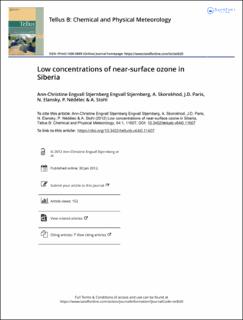| dc.contributor.author | Stjernberg, Ann-Christine Engvall | |
| dc.contributor.author | Skorokhod, A. | |
| dc.contributor.author | Paris, J.D. | |
| dc.contributor.author | Elansky, N. | |
| dc.contributor.author | Nedelec, P. | |
| dc.contributor.author | Stohl, Andreas | |
| dc.date.accessioned | 2020-04-14T12:22:49Z | |
| dc.date.available | 2020-04-14T12:22:49Z | |
| dc.date.created | 2012-06-22T16:38:18Z | |
| dc.date.issued | 2012 | |
| dc.identifier.citation | Tellus. Series B, Chemical and physical meteorology. 2012, 64 1-13. | en_US |
| dc.identifier.issn | 0280-6509 | |
| dc.identifier.uri | https://hdl.handle.net/11250/2650995 | |
| dc.description.abstract | Siberia with its large area covered with boreal forests, wetlands and tundra is believed to be an important sink for ozone via dry deposition and reactions with biogenic volatile organic compounds (BVOCs) emitted by the forests. To study the importance of deposition of ozone in Siberia, we analyse measurements of ozone mixing ratios taken along the Trans-Siberian railway by train, air-borne measurements and point measurements at the Zotino station. For all data, we ran the Lagrangian particle dispersion model FLEXPART in backward mode for 20 d, which yields the so-called potential emission sensitivity (PES) fields. These fields give a quantitative measure of where and how strongly the sampled air masses have been in contact with the surface and hence possible influenced by surface fluxes. These fields are further statistically analysed to identify source and sink regions that are influencing the observed ozone. Results show that the source regions for the surface ozone in Siberia are located at lower latitudes: the regions around the Mediterranean Sea, the Middle East, Kazakhstan and China. Low ozone mixing ratios are associated to transport from North West Russia, the Arctic region, and the Pacific Ocean. By calculating PES values for both a passive tracer without consideration of removal processes and for an ozone-like tracer where dry deposition processes are included, we are able to quantify the ozone loss occurring en route to the receptor. Strong correlations between low ozone concentrations and the spatially integrated footprints from FLEXPART, especially during the period summer to autumn, indicate the importance of the Siberian forests as a sink for tropospheric ozone. | en_US |
| dc.language.iso | eng | en_US |
| dc.rights | Navngivelse-Ikkekommersiell 4.0 Internasjonal | * |
| dc.rights.uri | http://creativecommons.org/licenses/by-nc/4.0/deed.no | * |
| dc.title | Low concentrations of near-surface ozone in Siberia | en_US |
| dc.type | Peer reviewed | en_US |
| dc.type | Journal article | en_US |
| dc.description.version | publishedVersion | en_US |
| dc.rights.holder | © 2012 Ann-Christine Engvall Stjernberg et al. | en_US |
| dc.source.pagenumber | 1-13 | en_US |
| dc.source.volume | 64 | en_US |
| dc.source.journal | Tellus. Series B, Chemical and physical meteorology | en_US |
| dc.identifier.doi | 10.3402/tellusb.v64i0.11607 | |
| dc.identifier.cristin | 931162 | |
| dc.relation.project | Norges forskningsråd: 184696 | en_US |
| cristin.ispublished | true | |
| cristin.fulltext | original | |
| cristin.qualitycode | 1 | |

